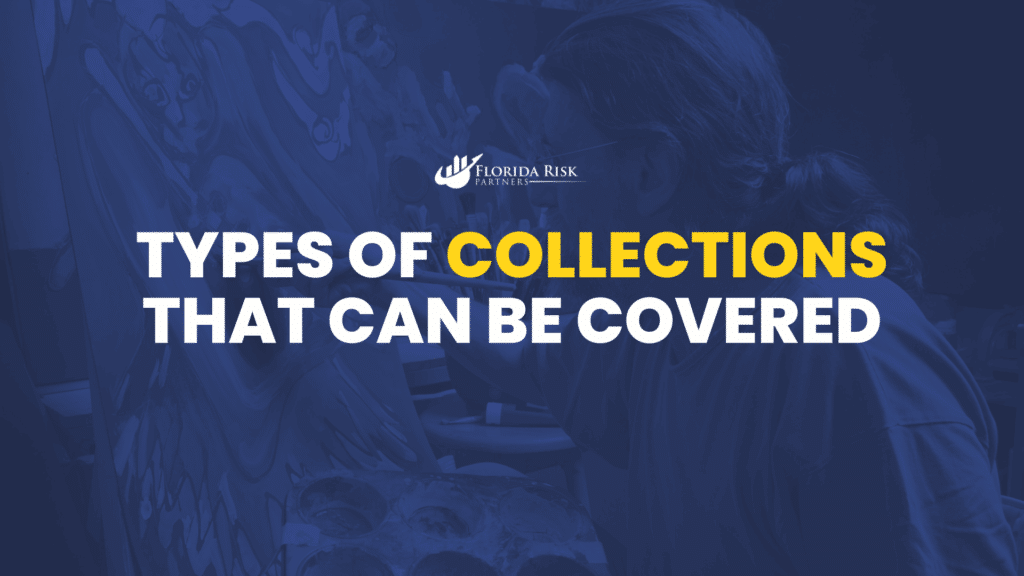-
Main Office: 1434 E. Bloomingdale Ave Valrico, FL 33596-6110
-
Phone: (888) 601-6660
-
Email: info@floridariskpartners.com

Collecting isn’t just a hobby—it’s a passion. Whether you’re curating a wine cellar, amassing rare coins, trading sports memorabilia, acquiring fine art, or carefully preserving vintage comic books, the items you collect often carry significant financial, historical, and emotional value. For many collectors, their collections represent years—if not decades—of dedication, investment, and personal enjoyment.
Yet despite this value, many collectors make a critical mistake: assuming their homeowners insurance provides adequate protection. In reality, standard homeowners policies fall short when it comes to properly insuring collections. From policy sublimits to exclusions and claims disputes, relying solely on your base policy can leave your collection vulnerable to loss, damage, or theft—with little to no reimbursement.
That’s where a Personal Articles Floater (PAF) steps in. In this post, we’ll explore the specific risks collectors face, break down how floaters work for collections, and help you understand how to customize coverage to preserve not just your collection—but your peace of mind.
Why Homeowners Insurance Fails Most Collectors
Homeowners insurance is built to protect general personal property—your couch, your television, your clothes—not the unique, irreplaceable, or highly valuable items you’ve spent years acquiring. Most policies include Coverage C: Personal Property, which generally pays up to 50%–70% of your dwelling limit. While this seems generous, it’s rarely enough when it comes to collections.
Here are the most common ways homeowners policies fail collectors:
1. Sublimits for Certain Categories
Policies often impose low sublimits for specific categories like:
- $200 for money or coins
- $1,500 for stamps
- $2,500 for firearms
- $2,500 for silverware
- $1,500–$2,500 for theft of collectibles
If you own a coin collection valued at $15,000 or a signed baseball valued at $5,000, your standard policy is likely only covering a fraction of that—if any.
2. No Coverage for Market Appreciation
Let’s say you bought a vintage comic book for $2,000 a decade ago. Today, it’s worth $15,000. If you file a claim under homeowners insurance, you’ll likely only receive the original purchase price or a depreciated value, not the appreciated market value.
3. Exclusions for Breakage or Accidental Damage
Standard policies often exclude breakage, accidental damage, or mysterious disappearance—common risks for items like china, glassware, collectibles, and artwork.
4. Actual Cash Value (ACV) vs. Replacement Cost
Homeowners policies typically pay claims based on actual cash value, which deducts for depreciation. This is problematic for collectors, as many collectible items don’t depreciate—they appreciate.
The Risk Landscape for Collectors
In addition to policy limitations, collectors face a unique set of risks that warrant special attention:
1. Theft
Collections—especially those involving precious metals, autographs, rare currency, or small high-value items—are attractive to thieves. They’re easy to transport and often untraceable.
2. Damage
Floods, fires, humidity, pests, and even accidents like dropping or knocking over an item can cause major damage. For example, spilled wine on a vintage comic or a shattered display case during a move can result in total loss.

3. Transportation and Storage
Collectors who attend conventions, transport items to auctions, or loan items for exhibit introduce more opportunities for damage or theft—none of which are reliably covered by a standard policy.
4. Market Fluctuation
Values of collectibles fluctuate over time. If your insurance coverage doesn’t reflect current values, you could be severely underinsured when you need it most.
How a Personal Articles Floater Protects Your Collection
A Personal Articles Floater is a type of insurance policy designed to specifically protect high-value personal property, including collections. It offers customizable, agreed-value coverage with broader protection than your homeowners insurance can provide.
Let’s break down the key benefits for collectors:
1. Scheduled or Blanket Coverage
You can insure items individually (scheduled) or as a group (blanket):
- Scheduled coverage is ideal for unique, high-value pieces—like a $30,000 painting or a $10,000 baseball card.
- Blanket coverage works well for large collections of mid-range items, like a wine cellar or stamp collection valued at $20,000 total.
This flexibility allows collectors to choose a strategy that matches the composition and value of their collection.
2. Agreed Value or Replacement Cost Coverage
Unlike standard insurance that pays ACV, floaters often pay claims based on:
- Agreed Value: The insurer and policyholder agree in advance on the value of each item.
- Replacement Cost: The cost to replace the item with one of like kind and quality.
This means if your $15,000 rare guitar is destroyed in a fire, you’ll receive the full insured amount—not a depreciated payout.
3. Worldwide Coverage
Whether your items are at home, in a storage unit, on loan to a museum, or with you at a trade show, most floaters provide global protection—critical for collectors who exhibit or travel with their items.
4. Coverage for Mysterious Disappearance
Many homeowners policies exclude mysterious disappearance. But with a floater, if a rare coin or card goes missing from your display case without any evidence of theft, you’re still covered.
5. Protection Against a Wide Range of Perils
Floaters often include protection for:
- Fire and water damage
- Accidental breakage
- Theft
- Natural disasters
- Loss during shipping or transit
- Vandalism
- Earthquakes (in some cases)
This comprehensive protection is essential for safeguarding the value of delicate or easily damaged items.
Types of Collections That Can Be Covered

A wide variety of collections can be insured under a personal articles floater, including but not limited to:
- Art: Paintings, sculptures, installations, prints
- Wine: Vintage or rare bottles, entire cellars
- Comics: Graded and ungraded collections
- Coins and Currency: Rare coins, bills, or complete sets
- Sports Memorabilia: Signed jerseys, balls, trading cards
- Antiques: Furniture, decorative items, historical pieces
- Stamps: Philatelic collections, rare stamps
- Collectible Toys: Vintage action figures, dolls, models
- Books and Manuscripts: First editions, rare books
- Fashion: Designer handbags, shoes, vintage couture
- Musical Instruments: Particularly high-end or vintage models
What You’ll Need to Get Started
To insure your collection properly, you’ll need to provide documentation to the insurer. Here’s what you should gather:
1. Inventory List
Include:
- Item description
- Purchase date
- Purchase price or current market value
- Photos
- Serial numbers (if applicable)
2. Appraisals
Professional appraisals help determine accurate and current values—especially important for rare or one-of-a-kind items. Insurance carriers often require appraisals for scheduled items valued above a certain threshold (e.g., $5,000).
3. Certificates of Authenticity
For art, autographs, and collectibles, proof of authenticity strengthens your claim and confirms legitimacy.
4. Receipts and Sales Records
These help establish provenance and value, especially for newer acquisitions.
We offer a free tool to help you document your collection:
Common Mistakes Collectors Make (and How to Avoid Them)
Avoiding the following mistakes will ensure your collection is properly protected:
Mistake 1: Assuming You’re Covered
Never assume your homeowners policy covers the full value of your collection. Read your policy and speak with an agent who understands collectible coverage.
Mistake 2: Failing to Update Values
Collections can appreciate over time. Regularly re-appraise high-value items and update your policy to avoid being underinsured.
Mistake 3: Storing Without Considering Risk
Storing your collection in a basement prone to flooding, or in an unsecured area, can increase your exposure. Make sure your storage practices align with your insurance terms.
Mistake 4: Not Reviewing Coverage Annually
As you acquire new pieces or sell others, your insurance needs change. Schedule an annual review to ensure your policy reflects your current collection.
Tailoring Coverage to Your Needs
The beauty of a Personal Articles Floater is its flexibility. No two collections are alike, and your insurance should reflect that. A knowledgeable insurance advisor can help you determine:
- Whether to schedule items or use blanket coverage
- What documentation is needed
- How to set appropriate limits
- Whether you need worldwide or transit coverage
- If any special endorsements (like for wine or firearms) are appropriate
Final Thoughts: Protect the Collection You’ve Worked Hard to Build
Collecting is more than a pastime—it’s an investment of time, money, and emotion. Whether your collection holds historical significance, market value, or simply personal joy, it deserves thoughtful protection.
A Personal Articles Floater gives you customizable, comprehensive coverage, designed specifically for the nuances of collecting. From agreed value protection to global coverage and beyond, this type of policy ensures that your treasures are safe, no matter where they are or what life throws your way.
Stay tuned for next week’s post, where we’ll take a look at insuring another category that people often forget about until it’s too late: high-value electronics and smart devices.
Call Us Or
Schedule an Appointment
Select an agent below to view our online calendars and select a day and time that works best for you or call us directly at 888-601-6660. When you use our online calendars, you will receive an email with more information.



